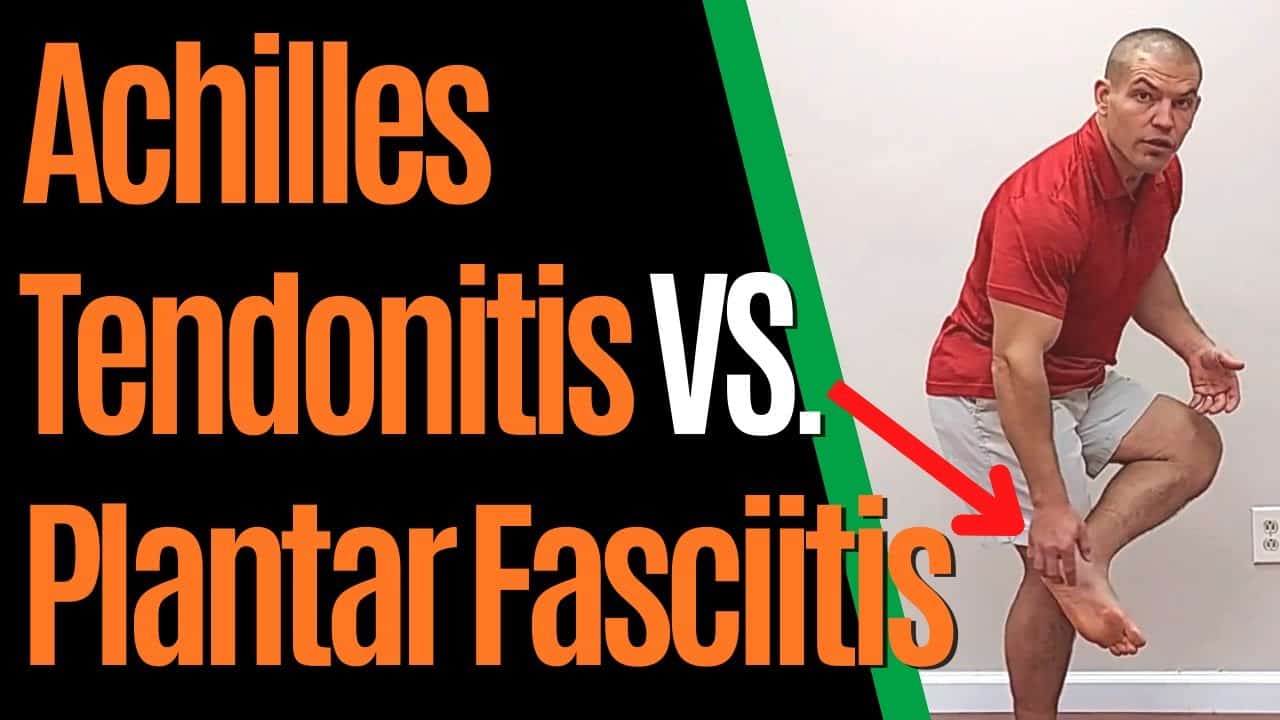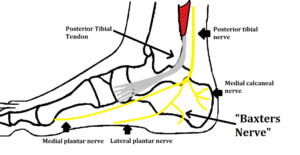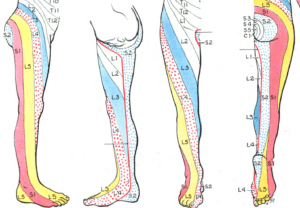How Do You Know If Your Heel Pain Is Achilles Tendinitis vs Plantar Fasciitis vs Something Else?
Watch the the video below to learn the difference between heel pain from Achilles tendonitis vs plantar fasciitis, plus tips to relieve both types of heel pain.
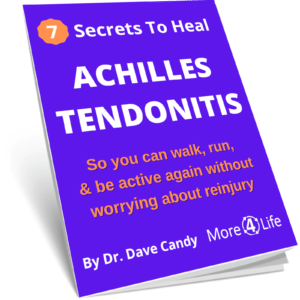
Different Types of Heel Pain:
Achilles Tendinitis vs Plantar Fasciitis
There are many causes of heel pain, but the most common ones are Achilles tendonitis and plantar fasciitis.
The two are actually quite different, but if you're not familiar with heel pain, you may wonder which problem you're dealing with, as well as how to fix it.
The first question to ask is:
Where Is Your Heel Pain Located?
Where Does Achilles Tendonitis Heel Pain Hurt?
Achilles heel pain will occur at the back part of the heel where the tendon inserts to the bone.
Different types of Achilles tendonitis may also refer pain or soreness up towards middle part of the tendon or even the calf. Pain may also refer to the sides of the heel, either inside or outside part of the heel.
Where Does Heel Pain From Plantar Fasciitis Hurt?
The plantar fascia is a broad tendon on the bottom of the foot that attaches to the heel bone, or calcaneus (see below).
Abnormal forces applied to the plantar fascia when walking or running can tug on the insertion point, causing heel pain or in some cases a bone spur.
When you have either a high arch foot that's too stiff, or your foot overpronates, you can irritate the plantar fascia, causing it to get inflamed (-itis ="inflammation")
However, not all foot pain is plantar fasciitis.
What Else Can Cause Heel Pain Besides Achilles Tendonitis and Plantar Fasciitis?
Heel Pain From Nerve Problems
Nerve problems are a highly under-recognized cause of heel pain.
Often nerve pain in the foot gets diagnosed as Achilles tendonitis or plantar fasciitis, especially if there's no numbness and tingling present.
For example, pain on the inside of the heel can be caused by the medial calcaneal nerve or Baxter's nerve as seen below.
The tibial nerve branches into the medial plantar nerve, lateral plantar nerve, and the medial calcaneal nerve.
The medial plantar nerve and the first branch of the lateral plantar nerve can cause foot arch pain that's often mistaken for plantar fasciitis.
Heel Pain From Lower Back Nerve Roots (L5-S2)
The nerve roots from the lower back can cause referred pain into the heel especially the L5, S1, and S2 nerve roots.
Attribution: Modified from Grant, John Charles Boileau, Public domain, via Wikimedia Commons
Often this type of foot pain occurs along with back pain and/or sciatica, but many times people don't connect their foot pain with their back pain or sciatica.
Stress Fractures In The Heel
They are small bone fractures or microcracks in the bone due to the repetitive stress placed on the bone.
Stress fractures occur when the bone is unable to repair fast enough to keep up with repetitive stresses placed upon it such as in long-distance running.
People with stress fractures will often experience constant pain, even at rest, and pain worsens with increased activity.
Heal Pain From Rheumatoid Arthritis (RA)
Rheumatoid arthritis is an inflammatory auto-immune condition that affects multiple joints and organ systems throughout the entire body, including but not limited to the heel, where the Achilles tendon attaches. RA is usually diagnosed by rheumatologists through blood tests.
While these other causes listed above can cause heel pain, Achilles tendonitis and plantar fasciitis are are the more common cause of heel pain.
We have several other posts about plantar fasciitis on our blog, so the remainder of this post will discuss Achilles heel pain.
If you do need help for plantar fasciitis though, click here to request an appointment with one of our specialists to find out how we can help.
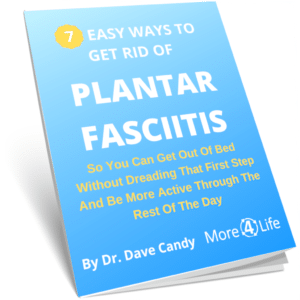
What Is Achilles Tendinitis?
Achilles tendinitis refers to an inflammation of the Achilles tendon that attaches the calf muscles to the heel.
Who is Achilles?
The tendon is named after the Greek warrior Achilles that was dipped in the river Styx to give him strength and immortality. However, since his mother held him by the heel to dip him in the river, this left an area of weakness where he was eventually shot with an arrow and died.
Likewise, the Achilles tendon represents an area of vulnerability to runners, jumpers, and other weekend warriors.
The calves transfer massive amounts of force through the foot when pushing off while running. Similarly, the calves and Achilles tendon have to absorb a lot of force when landing from a jump.
If the Achilles tendon is not in optimal condition, it can be subject to inflammation, tearing, or a complete rupture.
Two Types Of Achilles Tendonitis?
There are two types of Achilles tendonitis:
-
Insertional Achilles tendonitis
-
Mid-portion Achilles tendonitis
Insertional Achilles tendonitis is usually the type that causes Achilles heel pain.
Achilles Tendonitis vs Achilles Tendinopathy
The latin root -itis means inflammation.
Ironically, most Achilles heel pain is NOT inflammatory in nature.
Ultrasounds or MRIs of an injured Achilles tendon reveal a thickened tendon that gives off an increased signal without inflammatory markers.
Therefore, Achilles tendinitis is more properly called Achilles Tendinopathy, with -pathy meaning "pathological condition of".
That means if you have Achilles heel pain, you most likely have Achilles tendinopathy, NOT Achilles tendonitis.
So if you see me refer to the condition as "Achilles tendonitis", just know that it was done intentionally because that's what most people search for when they have Achilles heel pain.
(And I wanted you to actually be able to read this post so that you can get help for your pain 
The inflammation process is a good and natural process that the body uses after an acute injury to:
- Prevent further injury, and
- Start the body's natural healing response.
What Causes Achilles Heel Pain?
Achilles heel pain is usually caused from overuse rather than from an acute injury. That's why Achilles heel pain is usually NOT inflammatory.
Achilles heel pain can be caused repetitive microtraumas that accumulate over a long period of time from the repetitive, forceful activities such as running or jumping.
Occasionally the force from those activities can cause excess bone to be laid down causing a heel spur.
Heel pain in the Achilles can also be caused by prolonged, constant tension on the calves, such as people who stand all day for work, especially if they have stiff calves.
Finally, Achilles heel pain is common in "weekend warriors" who are typically not very active and then intermittently perform sudden explosive movements.
Examples of this include:
- Running to avoid getting wet by rain.
- Going for long hikes that you're not normally accustomed to it
- Returning to playing a sport after taking time off
- Playing pick-up basketball or pickleball once or twice a week without warming up properly.
All of the above scenarios are considered overuse injuries because the Achilles tendon is an “weakly loaded” state, and then it gets repetitively and forcefully tensioned beyond its capacity.
Why Do I Get Heel Pain In My Achilles In The Morning?
Morning heel pain can be from either Achilles tendinitis or plantar fasciitis.
As noted above, Achilles heel pain would be at the back and sides of the heel. In contrast, plantar heel pain is felt on the bottom of the heel and/or arch.
Click here to read my post on how to relieve plantar foot pain in the morning.
In Achilles heel pain, your Achilles tendon slightly shortens in its relaxed state when you're asleep.
The tendon is then rapidly tensioned at its insertion point at the heel when you initially get out of bed in the morning, thus causing heel pain.
Remember the section about heel pain from nerves though.
When you're stationary all night, your nerves aren't moving, and they can also be ore sensitive the first thing in the morning.
Similarly, the plantar fascia is rapidly stretched from its resting position during initial weight-bearing in plantar fasciopathy. The rapid stretch and compression of the Achilles tendon and/or plantar fascia is the cause of morning heel pain.
Why Do I Get Achilles Heel Pain From Walking?
The Achilles heel pain is associated with the tendon’s decreased tolerance to load after previous repetitive microtraumas.
During weight-bearing activities, such as walking or stairs, your calf muscles exert a lot of force to the Achilles tendon in order to propel your body forward.
Heel pain occurs when your Achilles tendon has a decreased capacity to transmit those forces applied by the calf muscles, so the Achilles tendon ends up tugging on the attachment site on the heel.
Achilles Heel Pain Treatment
Achilles Heel Pain Stretches
A conundrum exists when stretching the calf and Achilles tendon in people with insertional Achilles tendinopathy.
On one hand, the calf muscles are stiff, but the Achilles tendon is often OVERSRTETCHED.
As a result, you need to be able to stretch the stiff parts of the calf muscles without further overstretching the Achilles tendon.
Manual therapies such as manual trigger point treatment or dry needling can help with this.
Additionally, HOW you stretch your calf muscles can make a big difference. However, many people stretch their calf muscles WRONG.
Click here to learn how to stretch your calf muscles correctly.
Achilles Heel Pain Exercises For Strengthening
Because your Achilles tendon is deconditioned when you have Achilles heel pain, it's important to do strengthening exercises to recondition the tendon.
When you have Achilles tendinopathy, they oxygen-carrying capacity of the tendon is reduced, so the tendon starts to hurt with extended levels of activity such as distance running or walking long distances.
In order to rebuild the oxygen-carrying capacity of the tendon fibers, you need to do high-repetition exercise.
Heel raises are a good example of this.
Originally, the Alfredson protocol of 3 sets of 15 repetitions - both with knees bent and with knees straight - twice per day was recommended. That's 180 repetitions per day!
For people who have Achilles heel pain, this isn't always well tolerated though.
However, newer research has found that doing an "as tolerated" program doing as many reps as you reasonably can works just as well.
Maintaining correct technique with the Achilles tendon in a neutral position is also important while doing heel raises. That's because the Achilles tendon is really strong and resistant to straight up-and-down forces, but it's NOT as good at handling side-to-side (shear) forces.
Click here to learn how to do heel raises for Achilles tendon pain.
What Kind Of Shoes For Heel Pain In The Achilles?
Shoes that have a 1-1.5 inch heel or heel wedge are best for insertional Achilles tendinopathy.
The small heel gives into the calf and Achilles tendon stiffness. As a result, there is not as much tension on the Achilles tendon when walking or running.
If you don't want to wear a heeled shoe, you can also add a 1 inch heel lift to your normal shoes.
However, the increased heel height and arch support can temporarily decrease the pain, but it more likely will not be a long-term solution to Achilles heel pain because these types of shoes make your calves stiffer over the long-run.
Rocker-bottom shoes such as the Gravity Defyer are also helpful for Achilles tendonitis as they help reduce the load on the Achilles tendon when walking and running without making your calves as stiff.
Do Orthotics Help Achilles Heel Pain?
Over-the-counter and custom orthotics can help decrease Achilles heel pain.
Typically, custom orthotics will have a greater impact on decreasing your foot pain because it is built specifically to the configuration and shape of your foot.
Similar to shoes, foot orthotics that slightly increase the heel height and support the arch will decrease Achilles heel pain.
However, the root cause of your Achilles heel pain needs to be addressed in conjunction with proper foot support to not only eliminate your pain but prevent it from recurring.
How Long Does Achilles Heel Pain Last?
Achilles heel pain typically lasts 6-12 weeks depending on the degree of injury severity.
However, by getting proper treatment of it right away, you can help speed up your recovery time.
Want To Find Out How To Relieve Heel Pain Faster?
If you'd like to find out how to relieve your heel pain faster, click the button below to request an appointment with one of our specialists.

